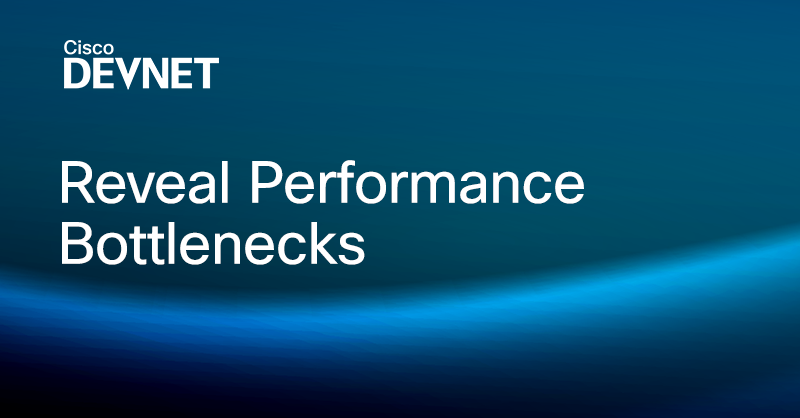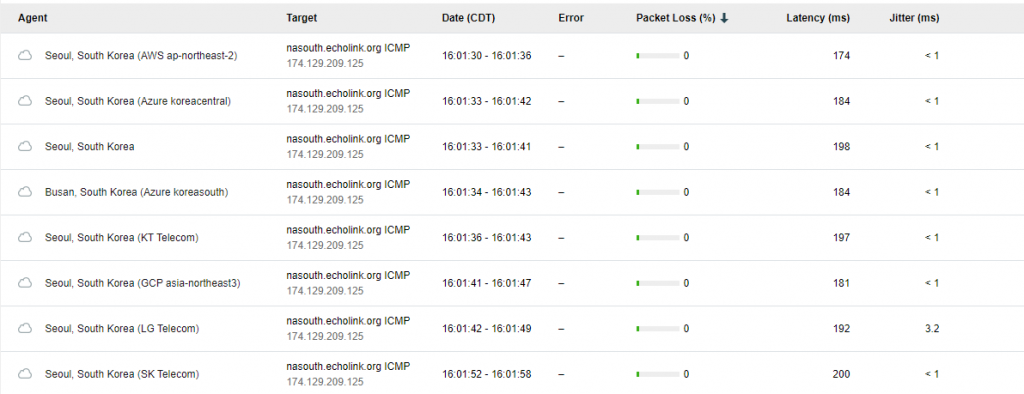- I recommend the Pixel 9 to most people looking to upgrade - especially while it's $250 off
- Google's viral research assistant just got its own app - here's how it can help you
- Sony will give you a free 55-inch 4K TV right now - but this is the last day to qualify
- I've used virtually every Linux distro, but this one has a fresh perspective
- The 7 gadgets I never travel without (and why they make such a big difference)
ThousandEyes Looking at EchoLink

I’m working with a Cisco service called ThousandEyes. Now, the best application of ThousandEyes would be to spot problems, especially with cloud services. If you offer a service in the cloud and customers are complaining about performance, ThousandEyes can reveal where the bottlenecks exist. Then you can execute a plan of action to get the issues addressed. But, indulge me a moment to explain the excuse I’m using to play with it.
I recently passed my Amateur Radio exam to get licensed again after letting my Advanced license expire 30 years ago. Before I share my new call sign, here’s a note for the benefit of non-hams (ham is common lingo for an Amateur Radio operator). It is customary to use a standard phonetic alphabet when giving your call sign on the air. For example, WB2GJ would be Whiskey Bravo 2 Golf Juliet. But someone might say WB2 George Jetson just for fun. (If you recognize the name, you’re dating yourself. And no hams were doxed for this blog; there is no WB2GJ.)
I mention this because the FCC assigns KI5VDI as my new call sign. I didn’t think any call sign could be worse than the one I had in Colorado, KB0FU. Yeah, say that one out loud and you’ll get it. But KI5VDI? I just know someone will say or at least think “KI5 Venereal Disease Infection”. So, I purchase a vanity call sign similar to my original Advanced call sign, WB2EWS. I get N2EWS. That’s good news. I’m now cured of Venereal Disease Infection.
As a revitalized ham, I find myself listening to a conversation on 2 meters. (We hams refer to frequency ranges by their approximate wavelength. The 144-148 MHz frequency wavelength is about 2 meters.) People you speak with on the 2-meter band are generally very close by. These signals don’t travel far unless you have the opportunity to do something fancy pants like bounce your signal off a meteor. Even then, voice communication would be virtually impossible. So, I am shocked to hear a local Texan talking with someone in South Korea. How? Repeaters extend the range on 2 meters so your signals can jump over objects like mountains or tall buildings, but even a daisy chain of repeaters isn’t going to reach South Korea.
It turns out they are using EchoLink. This free software lets you link your radio to your computer and connect anywhere with VoIP. You talk on the radio, and EchoLink forwards everything to the remote location, typically the other person’s radio connected to EchoLink.
I download and install EchoLink to give it a try. Being a Cisco guy, the first thing I think about is how reliable VoIP will be with this software and EchoLink destinations. Network latency and jitter can be a problem for VoIP.
This is where ThousandEyes (finally) comes in. ThousandEyes analyzes network traffic in detail. Fair warning: This is not a typical reason for using ThousandEyes, and I’m using ICMP to simplify the test. Normally you would use TCP and a port to get a more realistic view. Unfortunately, EchoLink doesn’t like tests on its VoIP port. But even these simple ICMP results are very interesting.
I see that EchoLink chooses a server in San Diego for my connection (nasouth.echolink.org). When I use EchoLink for ham radio, I’ll use it on my personal PC. But I’m testing it on my work PC, which adds a level of complexity since I use a Meraki router on the Cisco network. I install a ThousandEyes agent on my work PC so I can test the network from my work PC to the EchoLink server. The agent isn’t working. What’s my boggle? The agent is a Chrome extension and I’m using Firefox. No problem. I switch to Chrome and be well.
I run the first test. The path visualization (see Figure 1) shows some interesting information. The blue dots are nodes that have ThousandEyes agents. When I click on a blue dot, it shows the node information. The empty circles with numbers are unidentified node hops. The number tells you how many unidentified hops there are in that chain. Not every node in the Interwebs is equipped for ThousandEyes, yet.
The table view shows the latency and jitter. The jitter is higher than I expected, but it shouldn’t be a problem.

That is only half of an EchoLink connection, though. The other half would go from the contact in South Korea to the San Diego server. When you define a ThousandEyes test, you can pick multiple agents from anywhere in the world. I can even select multiple countries at a time for a single test. In this case, I only want one country, South Korea. But I can specify several South Korea nodes as starting points.

The table below shows that all but one source in South Korea have very low latency and jitter. But even the 3.2ms jitter is unlikely to be a problem.

Now let’s look at the paths. There are enough hops to be an IPA recipe. The red lines are links between two nodes where the delay is greater than 100ms. It is entertaining to hover over the dots to see traffic details. In one case, for Google (gcp asia-northeast3), the first jump is from South Korea to Illinois! Azure koreacentral is the only starting point with a path that has no delays. Since none of the delays add up to a significant latency, as shown in the above table, the delays are unlikely to be significant when using EchoLink.

Let’s try another location for Amber Heards and giggles. How about war-torn Ukraine? Surely this will show network problems.

I see two IPv4 agents in Ukraine, one in Kyiv and the other in Kharkiv. Kyiv uses Deltahost Company. Kharkiv uses Ukrainian Internet Names Center LTD. The results (see Figure 7) are impressive for a war torn country. Check out Figure 8 for the paths. No delays and no dead ends. Do we have Elon Musk to thank for this? I click on a few blue dots and see that several nodes are through Cogent Communications.


Overall, EchoLink communications should work very well, even to Ukraine.
I’m impressed with ThousandEyes. As more routers become ThousandEyes agents, there should be fewer and fewer unidentified nodes in test results. I’ll keep experimenting and report whatever may be interesting. You can check out ThousandEyes for yourself in the DevNet ThousandEyes Intro Learning Lab.
In the meantime, I encourage everyone to look into getting licensed for Amateur Radio. The average age of licensed hams is currently 68. Let’s get some of you young whippersnappers licensed. Until then, 73s and 88s to all you ham radio operators, and bye for now to the rest.
We’d love to hear what you think. Ask a question or leave a comment below. And stay connected with Cisco DevNet on social!
LinkedIn | Twitter @CiscoDevNet | Facebook | YouTube Channel
Share:

